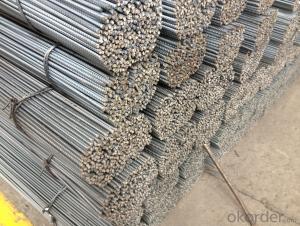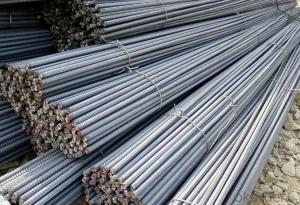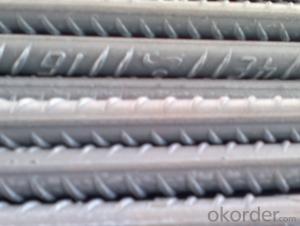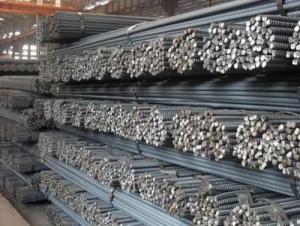Steel Rebar,Reinforcement Steel Bar,Structural Steel bar
- Loading Port:
- China main port
- Payment Terms:
- TT or LC
- Min Order Qty:
- 100 m.t.
- Supply Capability:
- 100000 m.t./month
OKorder Service Pledge
OKorder Financial Service
You Might Also Like
Product Description:
OKorder is offering Steel Rebar,Reinforcement Steel Bar,Structural Steel bar at great prices with worldwide shipping. Our supplier is a world-class manufacturer of steel, with our products utilized the world over. OKorder annually supplies products to African, South American and Asian markets. We provide quotations within 24 hours of receiving an inquiry and guarantee competitive prices.
Product Applications:
Steel Rebar,Reinforcement Steel Bar,Structural Steel bar are ideal for structural applications and are widely used in the construction of buildings and bridges, and the manufacturing, petrochemical, and transportation industries.
Product Advantages:
OKorder's Steel Rebar,Reinforcement Steel Bar,Structural Steel bar are durable, strong, and wide variety of sizes.
Main Product Features:
· Premium quality
· Prompt delivery & seaworthy packing (30 days after receiving deposit)
· Can be recycled and reused
· Mill test certification
· Professional Service
· Competitive pricing
Product Specifications:
Manufacture: Hot rolled
Grade: HRB335,HRB400,HRB500
Certificates: ISO, SGS, BV, CIQ
Length: 6m – 12m, as per customer request
Packaging: Export packing, nude packing, bundled
Deformed Steel Bar | ||
Diameter (MM) | Cross Sectional Area (MM2) | Theorectical Weight (KG/M) |
6 | 28.27 | 0.222 |
8 | 50.27 | 0.395 |
10 | 78.54 | 0.617 |
12 | 113.1 | 0.888 |
14 | 153.9 | 1.21 |
16 | 201.1 | 1.58 |
18 | 254.5 | 2 |
20 | 314.2 | 2.47 |
22 | 380.1 | 2.98 |
25 | 490.9 | 3.85 |
28 | 615.8 | 4.83 |
32 | 804.2 | 6.31 |
36 | 1018 | 7.99 |
40 | 1257 | 9.87 |
FAQ:
Q1: How many tons of steel products could be loaded in containers?
A1: Usually the steel products are delivered by bulk vessel because of the large quantity and the freight. However, there are no bulk vessel enter some seaports so that we have to deliver the cargo by containers. The 6m steel product can be loaded in 20FT container, but the quantity is changed according to the size, usually from 18tons to 25tons.
Q2: How do we guarantee the quality of our products?
A2: We have established an advanced quality management system which conducts strict quality tests at every step, from raw materials to the final product. At the same time, we provide extensive follow-up service assurances as required.
Q3: How soon can we receive the product after purchase?
A3: Within three days of placing an order, we will arrange production. The normal sizes with the normal grade can be produced within one month. The specific shipping date is dependent upon international and government factors, the delivery to international main port about 45-60days.
Images:

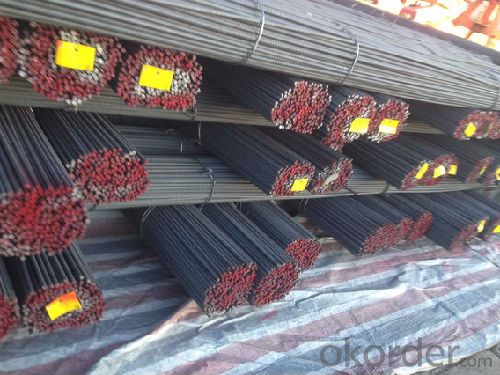
- Q:How are steel rebars installed in concrete structures?
- Steel rebars are installed in concrete structures by first determining the required placement and size of the rebars based on engineering specifications. Then, the rebars are positioned and secured in the desired locations within the concrete formwork. The rebars are typically tied together using steel wire or rebar connectors to ensure proper reinforcement. After the rebars are securely in place, the concrete is poured and allowed to cure, creating a strong and durable structure.
- Q:Can steel rebars be used in stadium construction?
- Yes, steel rebars can definitely be used in stadium construction. Steel rebars are commonly used in the construction of stadiums due to their high strength and durability. They provide structural support and reinforcement to concrete elements such as beams, columns, and foundations, ensuring the overall stability and safety of the stadium structure.
- Q:How do steel rebars contribute to the overall resistance against natural disasters?
- Steel rebars contribute to the overall resistance against natural disasters in various ways. Firstly, steel rebars are extensively used in reinforced concrete structures such as buildings, bridges, and dams, which are designed to withstand natural disasters like earthquakes and hurricanes. The addition of steel rebars increases the structural integrity of these concrete elements, making them more resistant to the forces exerted by such disasters. During earthquakes, the flexible nature of steel rebars allows them to absorb and distribute the seismic energy throughout the structure. This helps in dissipating the destructive forces and reducing the chances of collapse or severe damage. The presence of steel rebars also enhances the ductility of reinforced concrete structures, which means they can deform and flex without breaking, thus improving their overall resilience against seismic events. In the case of hurricanes or strong winds, steel rebars provide additional strength and stability to concrete structures. They act as reinforcement, preventing the concrete from cracking or crumbling under the pressure of high winds. The combination of the tensile strength of steel and the compressive strength of concrete creates a robust and durable structure that can withstand the powerful forces generated by hurricanes. Furthermore, steel rebars play a crucial role in the construction of flood-resistant structures. During flooding events, the strength and corrosion resistance of steel rebars ensure the structural integrity of buildings and other infrastructure, preventing them from being severely damaged or washed away. The use of steel rebars in flood-prone areas helps in creating resilient structures that can withstand the erosive forces of water and remain intact. Overall, steel rebars significantly contribute to the overall resistance against natural disasters by enhancing the strength, durability, and flexibility of concrete structures. Their presence improves the structural integrity and resilience of buildings, bridges, and other infrastructure, making them more capable of withstanding the destructive forces unleashed by earthquakes, hurricanes, and floods.
- Q:How do steel rebars contribute to the structural integrity of a building?
- Steel rebars, also known as reinforcing bars, play a crucial role in enhancing the structural integrity of a building. These bars are embedded within concrete structures, such as beams, columns, and slabs, to provide tensile strength and prevent cracking or failure under load. By reinforcing the concrete, steel rebars help distribute and resist the forces acting on the structure, ensuring its stability and durability.
- Q:What are the factors that affect the durability of steel rebars in concrete?
- There are several factors that can affect the durability of steel rebars in concrete. These include the quality of the steel used, the level of corrosion protection provided, the design and construction practices, the exposure conditions (such as moisture and temperature), and the presence of aggressive chemicals in the surrounding environment.
- Q:How do steel rebars affect the overall fire safety of concrete structures?
- Steel rebars can have both positive and negative effects on the overall fire safety of concrete structures. On one hand, steel rebars can help enhance the fire resistance of concrete structures. Concrete has a relatively low thermal conductivity, which means it does not conduct heat easily. However, when exposed to fire, concrete can crack and lose its structural integrity. The presence of steel rebars helps to mitigate this issue by providing additional tensile strength to the concrete. The rebars act as reinforcement, helping to prevent the concrete from cracking and collapsing under the intense heat of a fire. On the other hand, steel rebars can also pose some challenges to the fire safety of concrete structures. Steel is a good conductor of heat, which means that it can transfer heat from the fire to other parts of the structure. This can potentially lead to the weakening of the concrete and compromise the overall fire safety. Additionally, steel rebars can expand when exposed to high temperatures, which may cause further cracking and damage to the concrete. To address these challenges, various measures can be taken to improve the fire safety of concrete structures with steel rebars. The use of fire-resistant coatings or fireproofing materials on the rebars can help to minimize the heat transfer from the steel to the surrounding concrete. Fire-resistant insulation or fire barriers can also be installed around the rebars to further protect the concrete from the heat of a fire. Additionally, proper design and construction practices, including the appropriate spacing and size of rebars, can help to ensure that the concrete structure maintains its fire resistance. In conclusion, steel rebars play a crucial role in the fire safety of concrete structures. While they can enhance the fire resistance of concrete, they can also present challenges such as heat transfer and expansion. By implementing appropriate measures and construction practices, the negative effects of steel rebars on fire safety can be minimized, and the overall fire resistance of concrete structures can be improved.
- Q:What is the role of steel rebars in earthquake-resistant structures?
- The role of steel rebars in earthquake-resistant structures is to provide reinforcement and strength to the concrete elements. Steel rebars are embedded in the concrete to enhance its tensile strength and prevent cracking or collapsing during an earthquake. They help distribute the forces and stresses caused by seismic activity, enabling the structure to withstand and absorb the energy generated by the earthquake, thus reducing the risk of structural failure and ensuring the safety of the building and its occupants.
- Q:What is the minimum yield strength of steel rebars?
- The minimum yield strength of steel rebars is typically around 40,000 pounds per square inch (psi).
- Q:Are there any disadvantages of using steel rebars?
- Steel rebars have several drawbacks that should be taken into consideration: 1. Vulnerability to corrosion: Moisture and oxygen can cause steel rebars to rust over time, compromising their structural integrity. This issue is particularly concerning in coastal areas with high humidity levels or structures exposed to harsh weather conditions. 2. Heavy weight: Compared to alternatives like fiberglass or carbon fiber reinforced polymers, steel rebars are relatively heavy. This poses challenges during transportation and installation, especially in large-scale construction projects that require heavy machinery for moving and positioning the rebars. 3. Higher cost: Steel rebars are generally more expensive than other reinforcement materials, which can drive up the overall cost of a construction project. Moreover, the price of steel is subject to market fluctuations, making it difficult to accurately estimate the budget for reinforcement materials. 4. Conductivity issues: Steel rebars have high heat and electrical conductivity, which can be problematic in structures requiring insulation or in areas with stringent electrical conductivity requirements. In such cases, additional insulation or grounding measures may be necessary, adding complexity and cost to the construction process. 5. Environmental impact: The production of steel rebars is energy-intensive and contributes to greenhouse gas emissions. The extraction and processing of iron ore for manufacturing steel rebars can have significant environmental effects such as deforestation, habitat destruction, and air and water pollution. Despite these disadvantages, steel rebars continue to be widely used in construction due to their high tensile strength, durability, and proven track record in providing structural support. Efforts are ongoing to address these drawbacks through advancements in corrosion-resistant coatings and the exploration of alternative reinforcement materials.
- Q:What are the advantages of using high-strength steel rebars?
- Using high-strength steel rebars in construction projects brings forth several advantages. Firstly, compared to regular steel rebars, high-strength steel rebars exhibit a significantly higher yield strength. As a result, they can endure much greater tensile forces without deformation or breakage. This allows for the construction of resilient structures capable of handling heavy loads and forces, thus enhancing their durability and resistance to damage. Secondly, high-strength steel rebars possess a smaller diameter while still maintaining their strength, unlike regular steel rebars. This characteristic makes them suitable for use in limited-space areas or scenarios requiring a smaller concrete cover. Consequently, they prove particularly beneficial in projects with intricate designs or in regions prone to high seismic activity. Furthermore, high-strength steel rebars offer increased cost-efficiency. Due to their superior strength, fewer rebars are necessary in construction projects. As a result, material and labor costs are reduced. Additionally, the smaller diameter of high-strength steel rebars leads to a decreased requirement for concrete, further lowering expenses. Another advantage of high-strength steel rebars lies in their enhanced corrosion resistance. The increased strength of these rebars is often achieved by incorporating alloying elements such as chromium or nickel, which enhance their resistance to corrosion. Consequently, structures reinforced with high-strength steel rebars boast a longer lifespan and necessitate less maintenance over time. Lastly, the utilization of high-strength steel rebars facilitates the construction of lighter and more slender structures. Their superior strength-to-weight ratio permits the design of longer spans and taller buildings without compromising safety or structural integrity. Consequently, aesthetically pleasing structures are created, and architects and engineers enjoy greater flexibility in their designs. In conclusion, the advantages of employing high-strength steel rebars encompass increased strength, smaller diameter, cost-efficiency, enhanced corrosion resistance, and the ability to construct lighter and more slender structures. These benefits establish high-strength steel rebars as the preferred choice in various construction projects, ensuring durability, safety, and longevity.
1. Manufacturer Overview |
|
|---|---|
| Location | |
| Year Established | |
| Annual Output Value | |
| Main Markets | |
| Company Certifications | |
2. Manufacturer Certificates |
|
|---|---|
| a) Certification Name | |
| Range | |
| Reference | |
| Validity Period | |
3. Manufacturer Capability |
|
|---|---|
| a)Trade Capacity | |
| Nearest Port | |
| Export Percentage | |
| No.of Employees in Trade Department | |
| Language Spoken: | |
| b)Factory Information | |
| Factory Size: | |
| No. of Production Lines | |
| Contract Manufacturing | |
| Product Price Range | |
Send your message to us
Steel Rebar,Reinforcement Steel Bar,Structural Steel bar
- Loading Port:
- China main port
- Payment Terms:
- TT or LC
- Min Order Qty:
- 100 m.t.
- Supply Capability:
- 100000 m.t./month
OKorder Service Pledge
OKorder Financial Service
Similar products
New products
Hot products
Hot Searches
Related keywords
